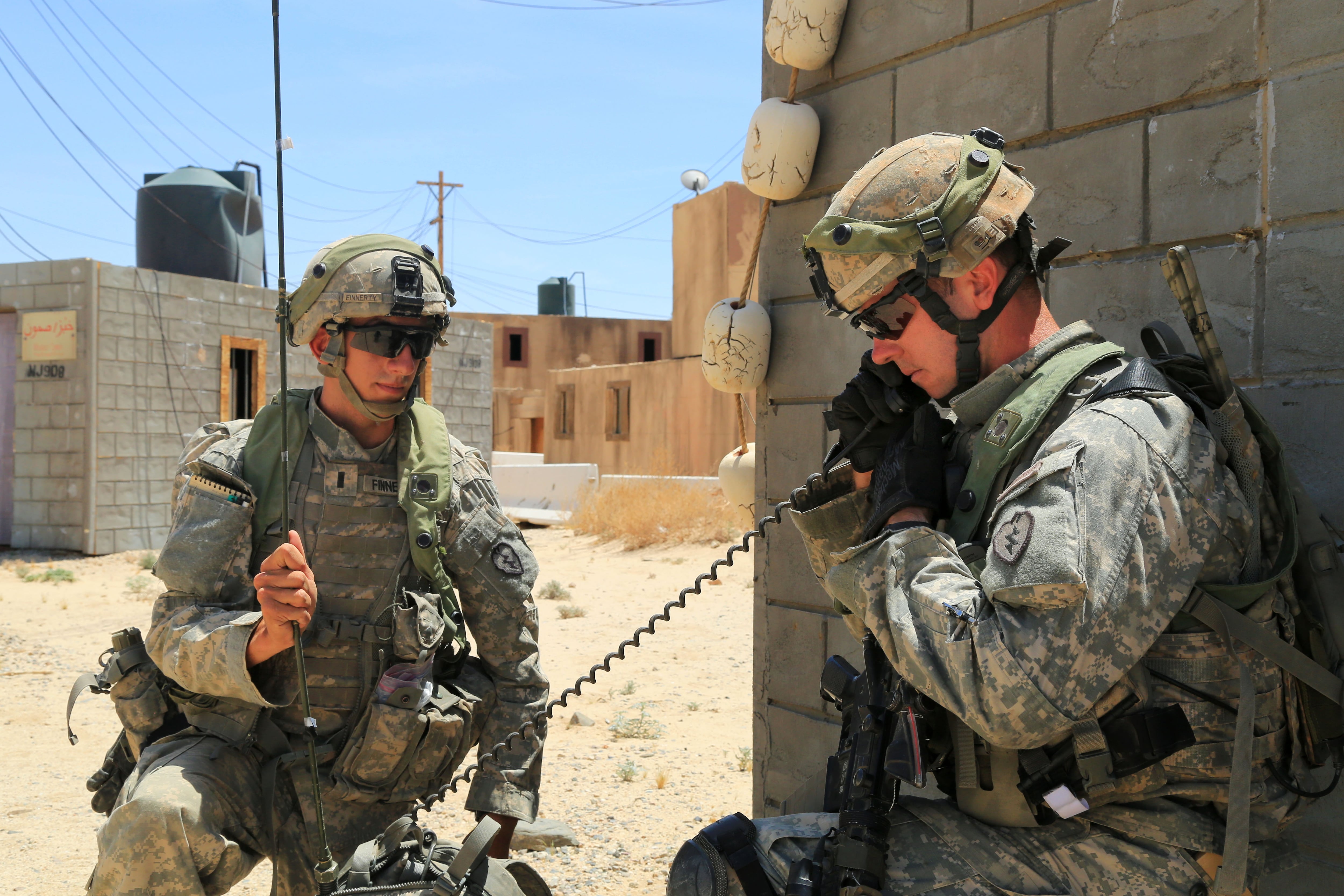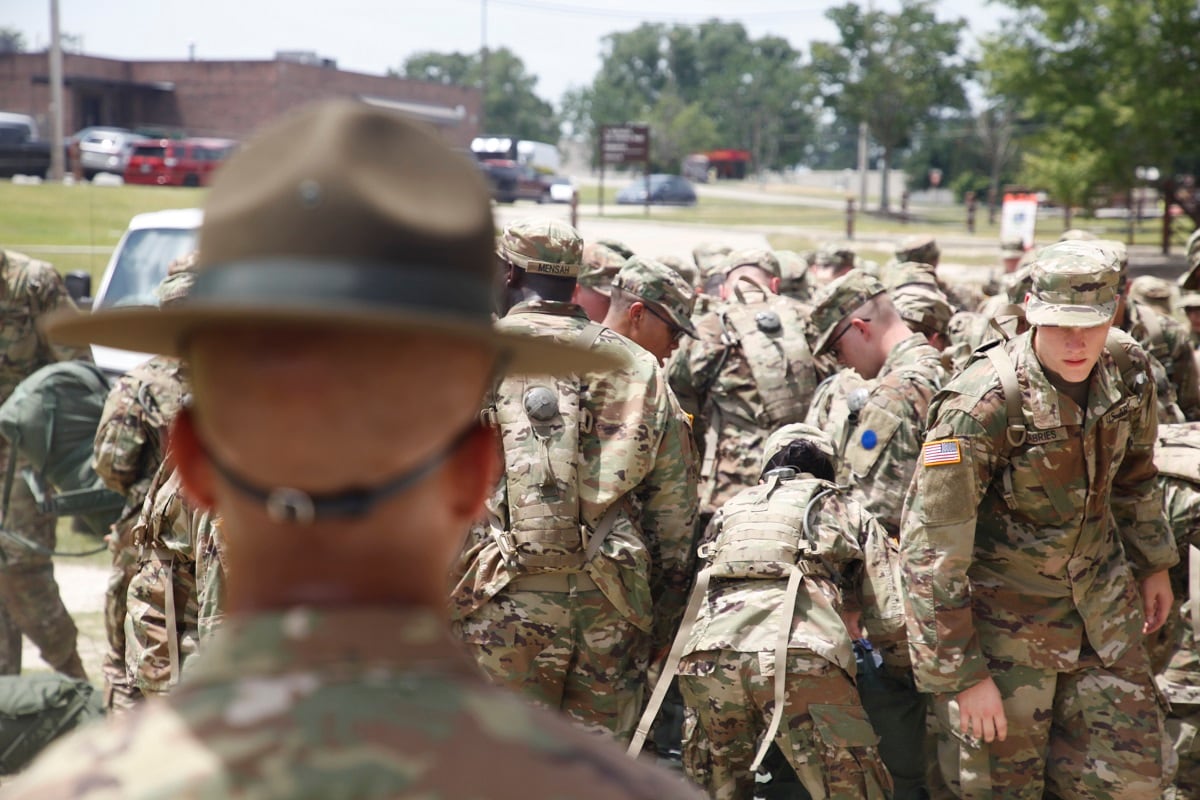Big changes are coming to basic training, according to the head of the Army’s Center for Initial Military Training.
After a multi-year review of the Army’s basic and advanced individual training programs, the service is piloting a long list of changes and tweaks, with an eye toward a full roll-out in late spring, Maj. Gen. Malcolm Frost told reporters Friday.
“We took out a lot of redundant areas that had crept in, that did not get after the basics,” he said.
At the top of the list, soldiers in basic training will now need to score a minimum of 60 points on each event in the Army Physical Fitness Test, versus the more remedial 50-50-50 requirement they have now.
And rather than spend time getting soldiers through the hand grenade and land navigation qualification courses in order to graduate basic, those skills will be incorporated into three new field training exercises, dubbed Hammer, Anvil and Forge.
There also will be changes in marksmanship training, with recruits required to qualify using iron sights, and a boost in the number of hours recruits will spend in hand-to-hand combat training.
And as the Army supported two ground wars over the past two decades, the service ditched some traditions like boot shining, and put less emphasis on ceremony and courtesy, in favor of quickly training war fighters to send straight into combat. However, some of that training also is making a comeback, in a bid to produce more disciplined soldiers.

Discipline
As a result of those more tactical changes, the Army found, one issue rose to the top of 27,000 leaders who responded to CIMT’s survey.
“The No. 1 thing that was asked for, five-fold, was discipline,” Frost said.
So CIMT set out to rebuild its program of instruction from the ground up, starting with codified training for recruits on what it means to be a soldier, how a soldier carries himself or herself — and there will be a test.
“What leaders have observed is that, in general, they believe that there’s too much of a sense of entitlement, questioning of lawful orders, not listening to instruction. Too much of a buddy mentality with NCOs and officers,” Frost said.
Drill sergeants will evaluate recruits on their discipline, inspect their bunks and bays, and hold drill and ceremony competitions to make sure soldiers are learning how to march, move in a tight formation and handle their weapons in the most basic way.
“It depends on which side of the fence you sit,” Frost said. “There are a lot of folks who say we need to go back to drill and ceremony, because we’ve lost a lot of the discipline of what it means to be a United States Army soldier.”
This won’t mean hours set aside for marching around outside their barracks, however, Frost said.
“The drill and ceremony is going to be interwoven — when they move to and from places, drill and ceremony will be dispersed inside of that,” he said. “So the movements won’t just be lollygagging, untactical movements. They’ll actually be executing some drill and ceremony when they move to and from the chow hall, when they move to and from the barracks.”
CIMT also developed some vignettes to include in every recruit’s blue book, with the history of major Army battles from Valley Forge to Baghdad, highlighting the Army values exemplified in each, as well as the story of a valorous soldier who fought in them.
“We really did not have a good centralized acculturation of what it means to be a United States Army soldier,” Frost said.
Fitness
The second issue on those surveyed leaders’ list was fitness, Frost said.
Years ago, in favor of helping a decreasingly in-shape recruit pool get through basic — and on the assumption that soldiers would work toward a passing APFT score at AIT and beyond — the Army lowered the required recruit score to 50-50-50.
But soldiers were still showing up to their first units unable to pass a real-life PT test, Frost said.
“If you graduate basic training on Friday and you go to AIT on Monday, you’re at 60 points on Monday at AIT,” Frost said. “Would we send a soldier to their first unit of assignment who wasn’t qualified on their weapon? No, we wouldn’t.”
And, he added, in units where drill sergeants prepare their recruits according to the 60-point standard, they’re able to hit that mark.
“We also think that if we put the bar where the bar should be, that both the trainees and the drill sergeants will get themselves to that level,” Frost said.
The requirement is waiverable by a battalion commander, however. If a soldier is very close to the 60-60-60 mark, a lieutenant colonel can use discretion to sign off on their PT scores.
The Army also wants soldiers to be better in hand-to-hand engagements, so combatives training will shoot up from 22 hours to 33 hours during basic.
“Quite frankly, combatives, it’s as much about confidence as anything else,” Frost said. “It’s confidence in yourself as a United States Army soldier, it’s confidence in your ability to be physically fit — and also, in the end, we think soldiers have to be able to defend themselves and their buddies.”
Move, shoot, communicate
CIMT discovered another troubling trend when it came to hand grenade qualification. It turns out that drill sergeants were spending hours at night, during their corrective training time, teaching trainees how to throw.
“We’re finding that there are a large number of trainees that come in, recruits from America, that, quite frankly, just physically don’t have the capacity to throw a hand grenade 20 to 25 to 30 meters,” Frost said.
In fact, it was taking three or four times the amount of time the program allotted for hand grenade training to properly prepare recruits.
Under the new changes coming to basic, they will still get the technical and tactical knowledge required to use the grenades, Frost said, along with time familiarizing themselves on the course. But they won’t have to pass it to graduate.
The same goes for land navigation.
“Just because we took it off as a requirement when they graduate does not mean that we won’t be conducting hand grenade and land navigation training,” Frost said.
Those will, however, still be required at infantry one-station unit training, Frost said, because they were part of basic infantry competency.
In the realm of basic warrior tasks and battle drills, basic training will now add movement to the standard buddy team fire course. Recruits will also have to qualify on the old-school iron rifle sight, in addition to the more advanced optics, Frost said.
“This gets back to dependency on what is the digital or the technological realm, and not having the foundational skills before you leap to the use of that technology,” he said.
In other words, if your close-combat optics fail downrange, it’s going to be a problem if you’ve never qualified on the analog version.
Trainees will also double the amount of time they spend on combat communication, including calling in reports and medevacs, but also hand and arm signals.
And medical training will get an upgrade, Frost said, from basic combat life saver and first aid skills to the Tactical Combat and Casualty Care usually geared toward medics. Trainees will also get time in the gas mask and protective clothing used in chemical and biological attacks.
“We’re increasing the discipline and esprit de corps in basic combat training, and we’re doubling down on the basics of fitness, shooting, weapons proficiency, movement, communications proficiency, and then surviving through the lens of medical efficiency,” Frost said.
All of these skills will be integrated into three new field exercises that build on one another, Frost said, rather than the previous standalone events.
The Hammer, Anvil and Forge FTX’s will evaluate discipline and fitness, as well as proficiency in events like shooting, land navigation and grenade-throwing.
These events will replace individual tests on combatives, obstacle sources, the gas chamber and first aid, as well as the previous End of Cycle test.
Despite some discussion in recent years about extending basic training to meet an updated set of requirements, the Army is sticking with the 10-week model.
With the end of the drawdown and an eye toward building the Army in the coming years, lengthening basic would cut down on the service’s ability to grow, Frost said.
For now, the Army is finishing up pilot testing at Fort Jackson, South Carolina, its largest basic training post.
“It’s been approved, the lesson plans are being approved now, and we think May or June, it’ll be in full force across all the Army training centers, in basic combat training,” Frost said.
Meghann Myers is the Pentagon bureau chief at Military Times. She covers operations, policy, personnel, leadership and other issues affecting service members.





